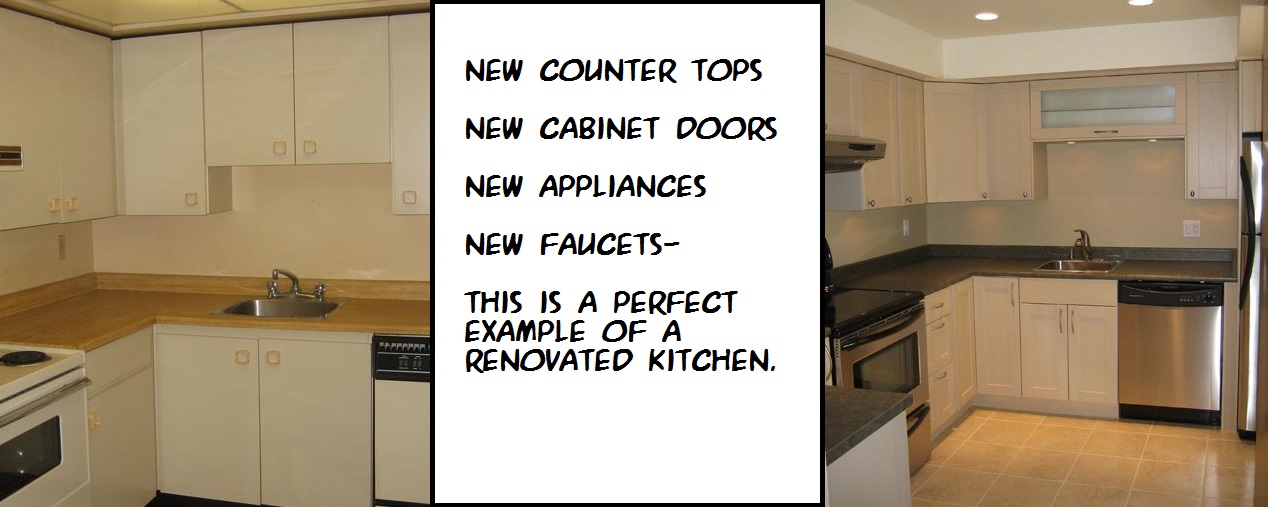Are remodeling and renovating different? Yes they are. These two terms are often used interchangeably in real estate. As real estate appraisers, whenever we see the word “remodeled” in one of our comparable descriptions, we always do a little fact-checking just to be safe. After scrolling through tons of comparable photos for every report, we find that more often than not, the agent’s description is wrong.
What is a Renovation?
‘
“Renovation” is a rather specific term, literally meaning “to make new again.” The term is (or should be) mostly applied to cosmetic changes- new kitchen faucets, counter-tops or cabinet handles, interior paint… these are all examples of renovation. Renovations don’t normally require any real structural work, and are almost always cheaper and less time-consuming then remodeling.
We see lines like “renovated with new paint!” in listing descriptions a lot- but getting a new cabinet or a fresh coat of paint alone is not a renovation. Renovation speaks more to a bigger picture- to take an out-of-date aspect of a property and update it into the modern age.
What is Remodeling?
Remodeling means “to change the structure of.” The couple at the top of this article are definitely remodeling. If you add carpet, siding, and a ceiling to your basement (effectively making it a finished basement), that’s remodeling. Getting an addition to your property is remodeling.
Take a look at the picture:
These people went all out. The cabinets have been completely redone, as well as the tiles on the wall, all of the appliances… they even added an island. They did not “renovate” to update a property into the 21st century alone, they went above and beyond- creating a new kitchen that’s probably bigger than any other in the neighborhood.
When it comes to making changes like wiring, plumbing, or any sort of remodeling for that matter- it’s important to let your appraiser know every detail. Maybe the new paint isn’t as obvious- and the wiring/plumbing is definitely not as obvious- yet they are still expensive changes that can significantly impact the value of a home.
Okay, What About Restoration?
Restoration and renovation are sort of opposites. Instead of renovating something older to make it look more modern, you restore it, making it look just as it originally was. If your property is in a historic district, there may be mandatory codes that require restoration.
You can do a historic restoration, but not a historic renovation- that would be a contradiction. Some classic examples of restoration: refinishing old wood surfaces, re-painting chipped or old paint the same color it previously was, redoing a slate roof, or restoring double-pane windows back to single-pane. Let’s say you have a newer home and have just been using that old study for storage. If you moved all your junk out of that room and added a desk, technically you’d be restoring your storage room back to a study, which was it’s original use. That’s just an example- don’t actually do that unless your willing to explain
In Conclusion…
So now you know. These terms are often confused…and misused. As a result, this attracts buyers who otherwise wouldn’t want to see your property at all… and that’s a waste of your time. Whether your restoring, renovating, remodeling, updating, redoing- whatever you want to call it- always tell your appraiser about any recent changes to a home. If we don’t know it’s there, we can’t incorporate those changes into the value.
 Jonathan Montgomery is the founder and president of the The Real Estate Appraisal Group, and has been a real estate professional since 1998. He has been a broker, an investor, and currently works full-time as an appraiser. He enjoys handling real estate appraisals in Washington D.C., Southern Maryland, and Northern Virginia.
Jonathan Montgomery is the founder and president of the The Real Estate Appraisal Group, and has been a real estate professional since 1998. He has been a broker, an investor, and currently works full-time as an appraiser. He enjoys handling real estate appraisals in Washington D.C., Southern Maryland, and Northern Virginia.
#treagroup #realestate






It is nice to see you doing the appraiser blogging Jonathan. I thought the three Rs I need to know are reduce, reuse, and recycle. I guess that what I get for doing a green remodel. 🙂
Thank you for this education